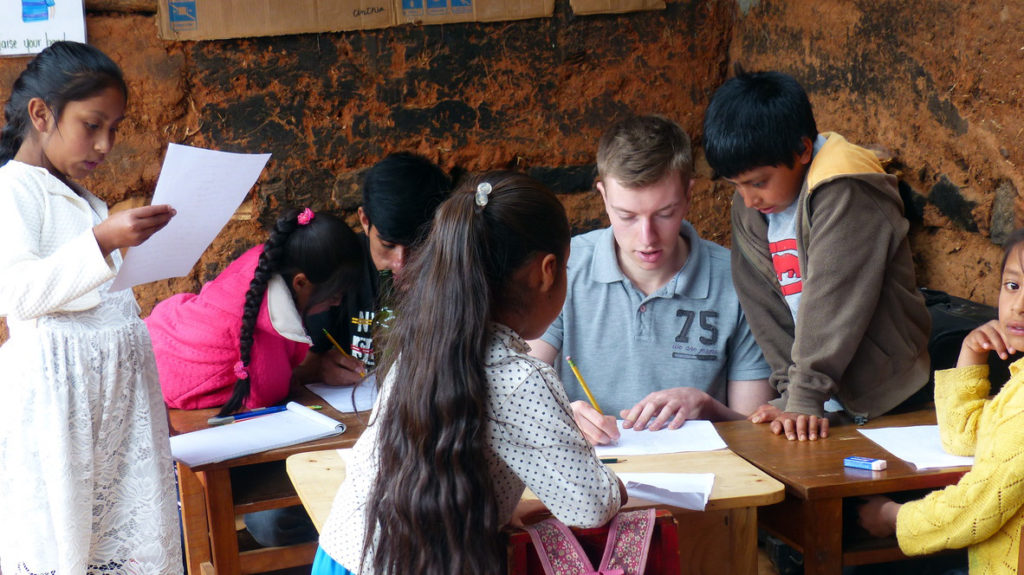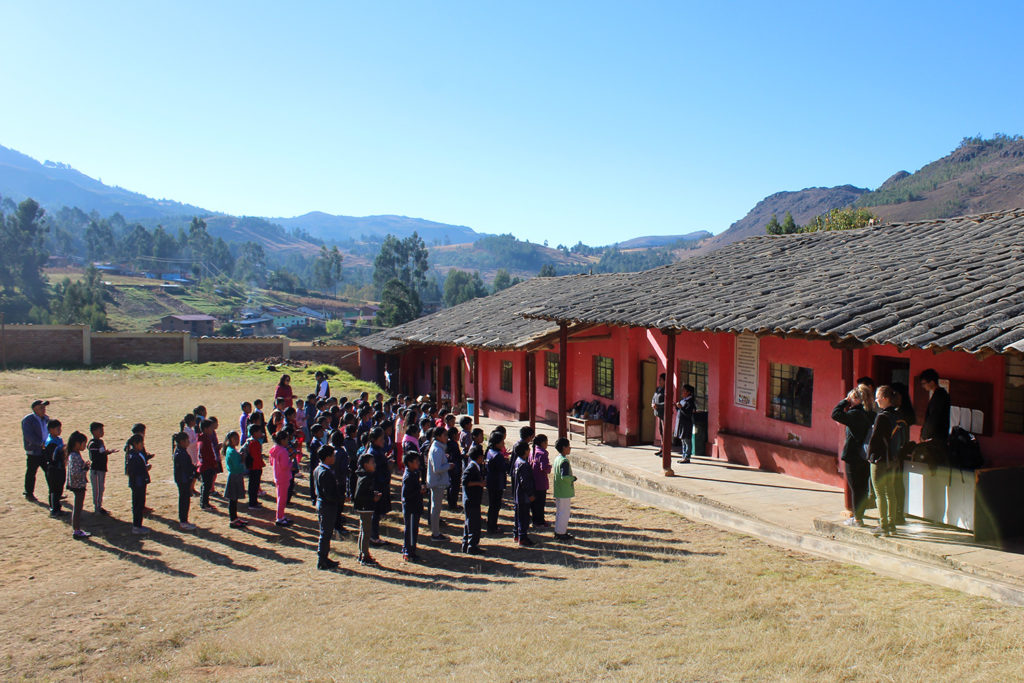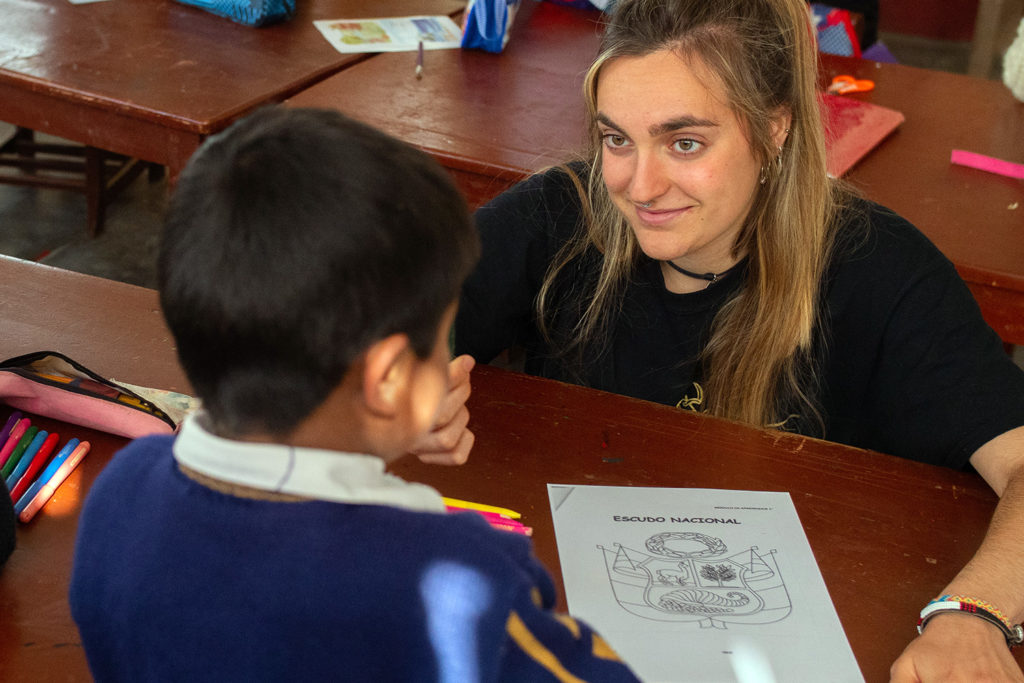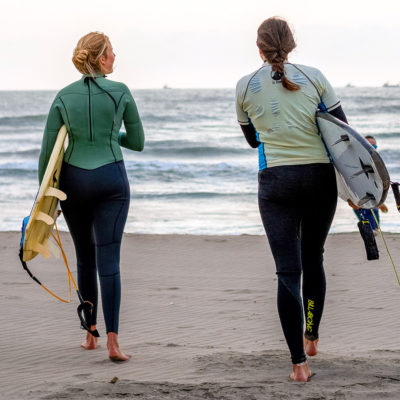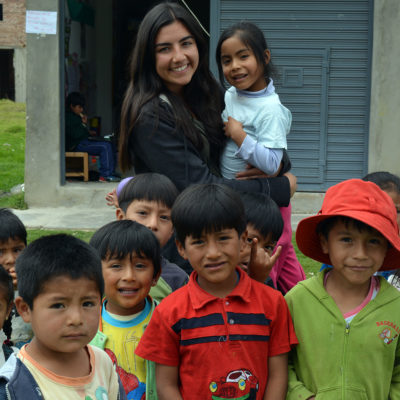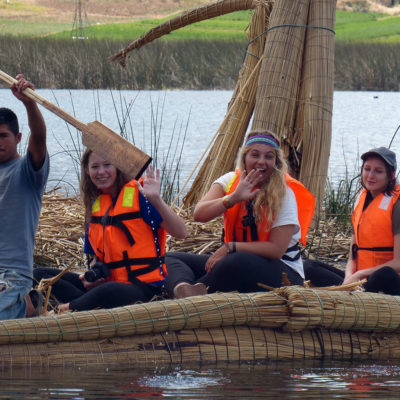You will teach half-days from Monday to Friday, either in the morning or the afternoon for about 3-4 hours. A typical day will most likely look like:
This schedule can be changed and/or amended depending on weather conditions, local conditions and unforeseen circumstances. During the summer and winter holidays there are no classes in Shaullio. Participants will instead supervise the children at the Banos Library where children create arts & crafts, play sports and engage in cultural activities.
Additional Equipment
Required
- Modest clothing (covering the knees and shoulders) is required while on school grounds
Optional
You are more than welcome to bring teaching materials/resources for your class such as:
- Interesting board games
- Books/Comics
- Musical instruments
- Worksheets
- Cultural items of interest
- And anything else you think will help!
Location
You will be staying in the district of Puyllucana which is a small village found in the east-northern part of Cajamarca.It is a beautiful location with great weather and friendly locals.
Located only a short distance away from Cajamarca city (Capital and largest city of Peru’s Cajamarca Region, enriched in culture and history), this quiet location provides a relaxing atmosphere after a day out. The accommodation has a beautiful view of the Andes Mountain Range and is close to the Amazon Rainforest, it will bring you back to South American nature!
Accommodation & Food
You will be staying in our accommodation centre in Puyllucana, Rural Cajamarca countryside. The house is made with traditional materials such as adobe and stone, it also has a large garden. Wi-Fi will be available only in common areas. We recommend also using 3G data if staying connected is important to you. All participants are expected to be environmentally aware and to use all resources with restraint, especially water, paper and electricity. Although rooms will be cleaned daily by staff, you will be expected to clean up after yourself, and to play your part to keep accommodation neat and organised.
Available Room Types
|
|
Standard Room
|
|
All meals included
|
Yes *
|
|
Free beverages
|
Yes **
|
|
Persons per room
|
3-5
|
|
Wifi in public areas
|
Yes
|
|
Laundry facilities
|
Yes ***
|
|
Safety box
|
No
|
|
Lockable rooms
|
No
|
|
Hot shower
|
Yes
|
|
Private bathroom
|
No
|
|
Bed linen
|
Yes
|
|
Towels
|
No
|
|
Heating
|
No
|
* 3 meals on weekdays, 2 on weekends
** Tea, Coffee, drinking water
*** For a small fee
Food Arrangements
The food will be typically Peruvian meaning lots of corn, beans, rice, chili peppers, potatoes, wheat, and other grains, all very vegetarian friendly. Keep in mind that some local dishes may be spicy!
Facilities
Although there are many restaurants around this small town, “Menu centres” are a cheaper popular local choice. Known as a “Menu”, here you are offered soup and entrees before digging into your main meal and are usually accompanied by a drink, usually made from barley or tropical fruit. Menus have a smaller range of food, but are cheaper and more convenient. They act as the ‘fast food’ for the locals, who tend to dislike western fast food outlets. Local shops are within walking distance. A short walk from our accommodation site will bring you to convenience local shops, for all your immediate shopping needs.
Transportation
Our accommodation is about 3.10 Km from the main square of Baños del Inca. This is roughly 8 km, about 30-40 minutes away from the Cajamarca city centre by public transportation.
“Moto-taxis” are also available for quick rides around town (up to 3 people round trip cost Banos del Inca 2 – 3 soles)
Internet use
There is Wi-Fi in your rooms as well as public areas at your accommodation, but there is also an internet cafe in the main township where you can access wifi from when you are not at the centre.
Money
There are numerous shops and ATMs in the centre of town.
Medical
We will have a basic first aid kit on site, but there is a clinic available in Banos del Inca. A hospital and various clinics are in nearby Cajamarca for any emergencies or health issues that may arise.
Mandatory Orientation Day
On the Monday of your first week at this location, you will join our orientation day, to familiarise you with the surroundings as well as local culture. Your program will continue as usual from Tuesday onward throughout the rest of the week.
Schedule
- Introduction meeting, House rules, Setting Expectations, Health and Safety Advice and handling of documents.
- Peruvian Do’s and Don’ts,Peruvian Culture Lessons and Spanish Language Lessons.
- Tour around the compound and local area; where to find local shops, and arrange a sim-card if necessary.
- Lunch
- Small hike to ‘white crosses hill’ where you can have Thermal Baths in Banos (Optional) and a massage session (Optional) .
- Activities & Events
- Cooking Lessons
Join your cook as they prepare meals for you and other participants. Take notes, learn new recipes, traditional food preservation techniques and more! Try not to spoil your dinner as you learn!Watch the local farmers near your accommodation, as they tend to their animals in daily rituals like shearing and milking.
Sights & Surroundings
Chiclayo
You can easily reach Chiclayo, Peru’s fourth biggest city, by public transport which is cheap and frequent. Chiclayo offers shopping centres, a cinema and nightlife, but it is also a major traffic hub in northern Peru. This makes it easy to travel on the weekends or after your program. There are plenty of small restaurants or shops around the area. There is an active surfing community and it is easy to make local friends, we can also point you to our Tandem Skydiving program and some other events.
Huanchaco
Only 12 km outside Trujillo. Once a quiet fishing hamlet, the town is now one of the best places for surfing.
Trujillo
Founded by Francisco Pizarro in 1534, Trujillo has 709,500 inhabitants. It is the home of the beautiful Plaza de Armas and its glamorous colonial. 4 hrs from our accommodation, this city by the ocean is referred to as the everlasting spring, where temperature is usually 32ºC, and where the very important Festival de la Marinera takes place.
Having said that, the main reason why most people pass through this coastal city is to visit one of Peru’s top-attractions: the Chimú adobe city of Chan Chan.
Chan Chan
Built around AD 1300, Chan Chan is the largest pre-Columbian city in the Americas, and the largest adobe city in the world. You can visit it by taking a combi from C/España. The ticket (10 S) includes entrance to the Nik-An temple, the Chan Chan museum, the Huaca la Esmeralda and the Huaca Arco Iris.
A bit further from the city, the Huaca del Sol y la Luna is over 700 years older than Chan Chan and belongs to the Moche culture. The temple is filled with icons representing Ai-Apaec, the god of the mountains, feared for provoking phenomena like El Niño. To stop him from sending heavy rains, the Moches would offer him human sacrifices.
Kuntur Wasi
The ruins of a religious structure in Peru’s northern highlands only 2 hours from our accommodation.
Cajabamba, Huamachuco
Located 5 hours away is a northern Peru town, rich with history, politics, religion, culture and hometown of the international famous muralist Jose Sabogal. Here, you can also visit unspoiled archeology sites and old monuments.
Bambamarca and Chota
Located 3 and 4 hours away, respectively, these towns are known for their festive activities in the months of June/July.
Leymebamba and La congona
Six hrs driving up north, with a little more than 4000 souls, Leymebamba is the perfect, quiet place to try visit La Congona, it can be reached on foot by hiking uphill from Leymebamba.
Museum of Leymebamba is just half an hour walking from Leymebamba. Inaugurated in June 2000, the Museo Leymebamba displays more than 200 mummies and their burial offerings recovered in 1997 from the Laguna de los Cóndores by a salvage Project directed by Centro Mallqui. Once at risk from looters and vandals, today this valuable collection is housed in the Museo Leymebamba. An initiative of The Bioanthropology Foundation Peru-Centro Mallqui, construction of the Museo Leymebamba was made possible by a donation from a group of Austrian citizens, as well as by funds from other private donors.
Chachapoyas
Also known as the Warrior of the Clouds, the Chachapoyas were a pre-Incan civilisation who lived in the cloud forests of present-day Peru. Chachapoyas contains intriguing archeological sites to explore, however the drive is 12 hours away from our Center, so good planning will be required.
Kuelap: The second Machu Picchu
Famous fortress of the mystic “cloud warriors”. One of the very few places never conquered by the Incas. Visitors describing Kuelap indicate that it is “as impressive as Machu Picchu” while it is by far not as crowded or expensive.
The government just recently decided to invest heavily into tourist infrastructure around Kuelap. Be one of the last persons discovering it while it is still relatively unknown!
Gocta
The waterfall of Gocta (771m) is amongst the highest in the world. Although methods of measurement are debatable, it got recognized as the world’s third highest waterfall, right after Angel Falls (Venezuela) & Tugela Falls (South Africa). Combine your visit with Kuelap and pick Chachapoyas as your homebase to have an adventurous weekend!
Transportation
From this location we provide free transport to your next program at the following location(s):
Lambayeque (Chiclayo)
Huanchaco
Chiclayo

